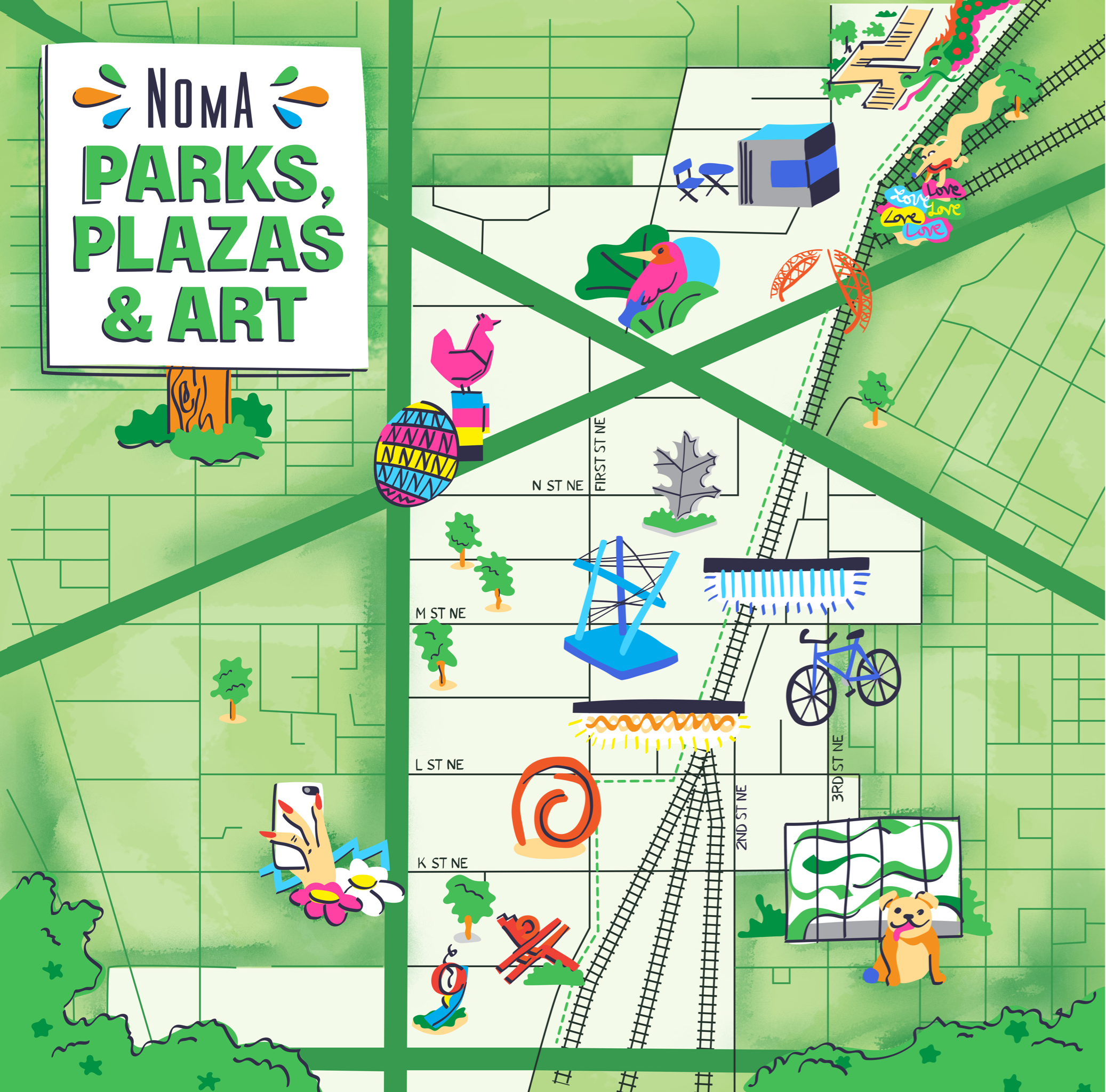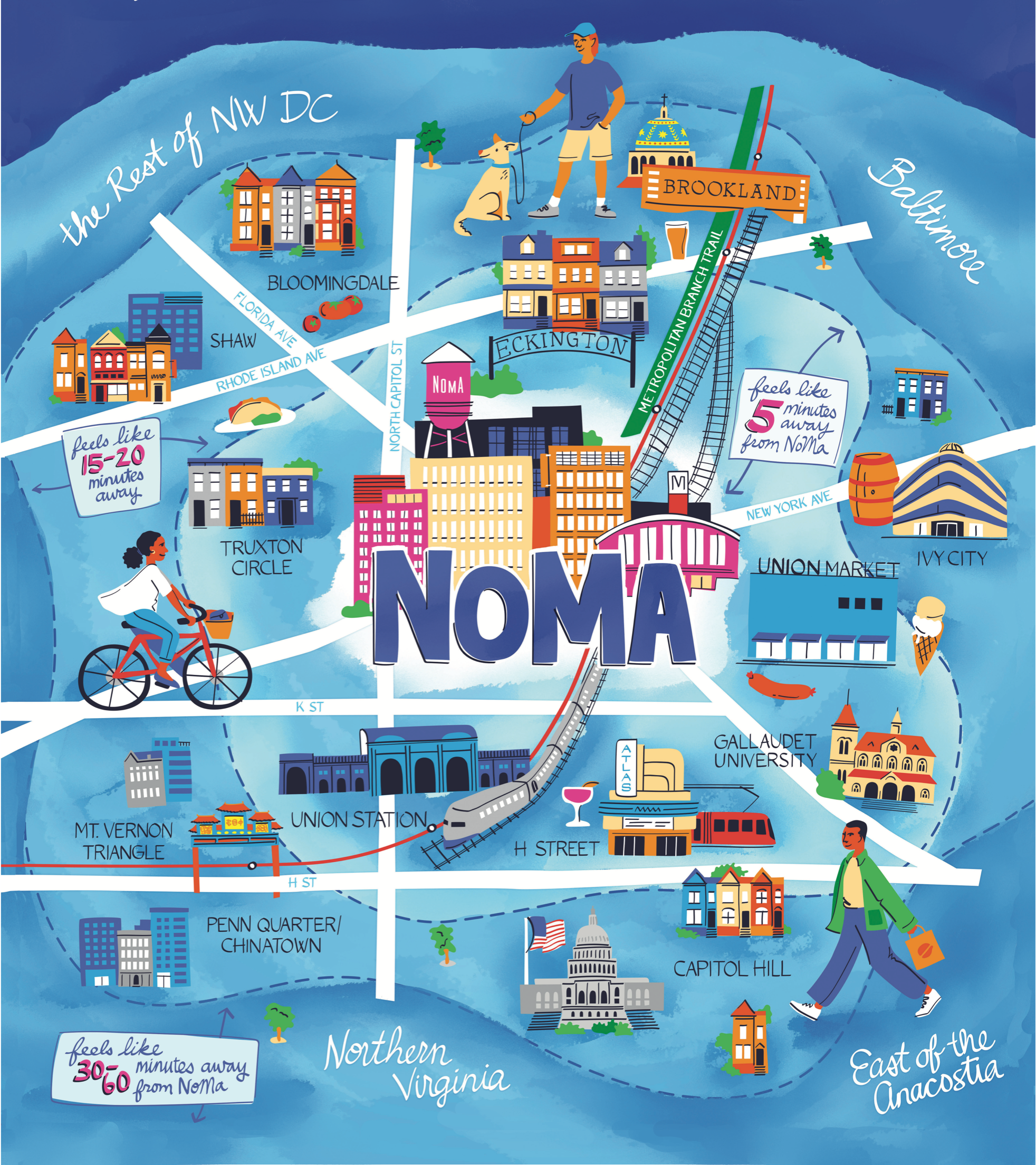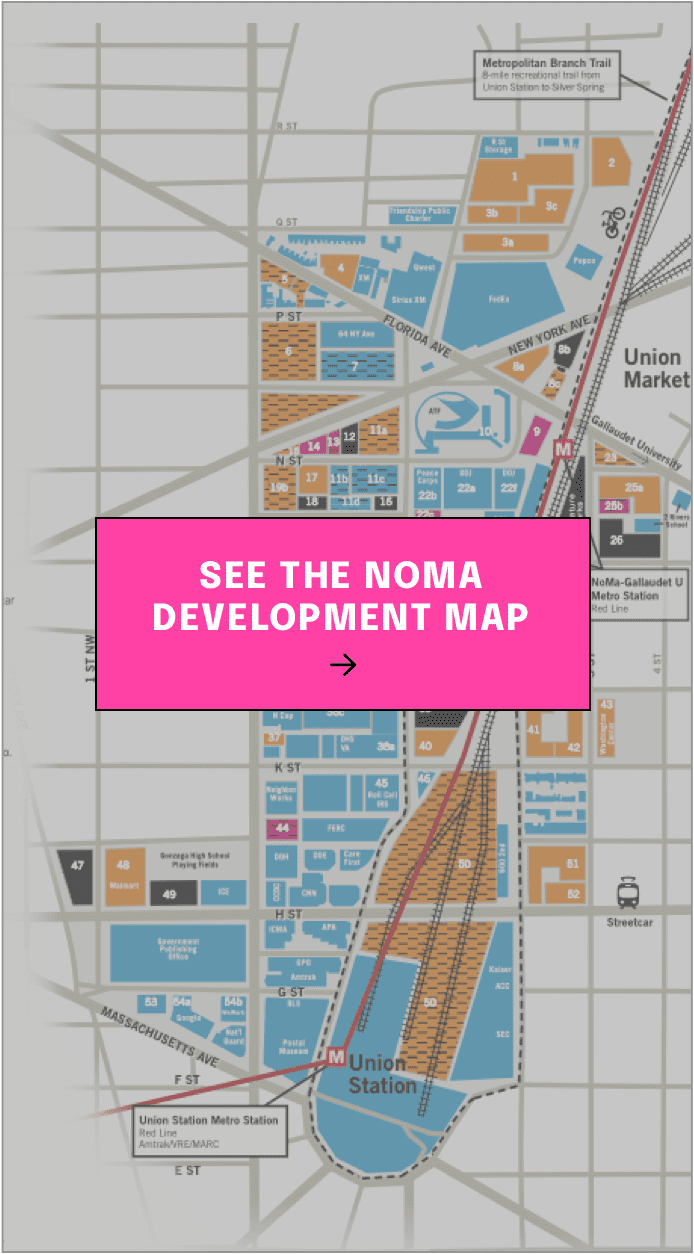NoMa Now (2024)
A snapshot view of the NoMa neighborhood, and of the work we do to build, support, care for, promote, and celebrate it.
December 2024 — Updated to include more recent information and the work completed since the inception of the plan in late 2021.
NoMa Business Improvement District strives to be both a vocal champion and an effective steward of the NoMa neighborhood on behalf of all of its businesses, employees, residents, visitors, and the city as a whole.
In our role as cheerleader, we promote NoMa, attracting attention and business activity. We host our own events and sponsor the events of others. We create and celebrate public art. And we connect visitors, workers, and residents to experiences and opportunities they can enjoy.
Our stewardship of the neighborhood is evident in the work of our Ambassador Operations team, cleaning and beautifying the streets and public spaces. And behind the scenes, our staff is coordinating and communicating, building relationships and engaging stakeholders to create long-lasting investments and commitments to what NoMa can become.
Supporting & Growing NoMa Businesses
The NoMa BID provides a vital layer of support for the businesses within Greater NoMa. We know that a thriving business community runs on diversity—diversity of ideas, of sectors, of sizes, and of target markets. We work hard to connect businesses to the people who live and work in NoMa, and to cultivate a physical and cultural environment where everyone can flourish.
We connect NoMa’s businesses with advice, guidance and promotional support, we conduct and analyze research, and perhaps most impressively, we build and maintain dazzling public spaces. We’re always on the lookout for new ideas and approaches to serving businesses and their employees, and we create adaptive communication channels for owners, tenants, managers, and workers to connect with us and provide feedback.
Cultivating Community & Identity
NoMa has experienced dramatic change since the NoMa – Gallaudet University Metro Station was built in 2004. Its identity continues to develop as a growing volume of new residents, businesses, institutions, and public space improvements make their mark.
When residents, employees, and visitors of these parts think about NoMa, they don’t think of lines on a map, but instead think of a growing and vibrant neighborhood that provides convenient access to the rest of DC and the region. When employers think about NoMa, they see an affordable and accessible alternative to downtown.
Throughout the input phase of this plan, we heard from employees, residents, and stakeholders that community & identity represented a next frontier for NoMa, but conversely that the BID could not directly create them. Instead, the strategy we’ve embraced is to create the spaces, experiences, and opportunities that will help community and identity develop, grow, and flourish.
Our Successes & Assets
NoMa’s success is evident in everything from the large number of cranes dotting the skyline to the thriving businesses that line the streets and fill the office towers. As this plan kicks off, the neighborhood is in the middle of another construction boom, continuing to attract large volumes of private investment. Currently (Summer 2021), the NoMa BID comprises 12.6 million square feet of office space, 5,922 multifamily residential units, 622 hotel rooms, and 425,000 square feet of retail. When the buildings currently being built are completed, all of these numbers will have increased, some quite dramatically:

Public investment in NoMa has been just as foundational to the neighborhood’s success. The NoMa Parks Foundation is wrapping up its execution of the District of Columbia’s $50 million investment in NoMa for the creation of public park spaces. And tens of millions more will be applied to projects such as the reconfiguration of the intersection at New York and Florida Avenues NE to calm traffic and create stunning new public plaza and green spaces, the replacement of the H Street Bridge, the addition of bike lanes on Florida Avenue NE and K Street NE, and new Bus Priority measures on H Street NW.
But NoMa’s oldest and best asset remains the same: location, location, location. As the business focus and cultural attention of the city shift eastward, NoMa is perfectly positioned to become a new hub of DC life.
NoMa in 2024 continues to grow, though the lasting impacts of the pandemic are increasingly evident. This year, we celebrated the completion of nearly all remaining buildings under construction in the neighborhood. However, the challenging economic
climate has slowed new development, and, for the first time in many years, there is only one construction crane in NoMa’s skies. Even so, there are promising signs that momentum will return. The question facing NoMa is not whether it will grow, but when.
The NoMa Business Improvement District worked hard to fill its streets with vibrant art, lively street life, and dynamic events that highlighted the best of what the neighborhood has to offer. The NoMa BID in 2024 is incredibly thankful for the unwavering dedication of our stakeholders, residents, and hardworking staff, and we remain committed to the continued health, stability, and success of NoMa, whatever the future may bring.
NoMa’s continued growth remains our best measure of success this year. The ongoing construction boom is drawing to a close, with all of the remaining buildings under construction having been delivered in 2024, comprising 1,383 new residential units and
18,500 square feet of retail space. With those additions, the NoMa BID currently (Fall 2024) comprises 12.65 million square feet of office space, 12,299 multifamily residential units, 1,356 hotel rooms, and 657,805 square feet of retail.
NoMa’s Retail
NoMa is early in its current retail boom with more than 175,000 square feet of retail space delivered in the past two years. Our retail strategy—still in its preliminary stages—will allow us to make the most of these opportunities, bringing exciting and unique operators to NoMa like Ted’s Bulletin. Retail vacancy is around 40 percent (an increase of 6% over 2022), largely driven by the above increase in supply.
NoMa’s Residential
After a very strong year in 2022, residential growth has slowed. NoMa added 640 residential units but is still seeing strong leasing activity, showing that the appeal of the neighborhood remains high. Construction of residential buildings continues to reshape the neighborhood. To date, an additional 1,463 multifamily housing units are under construction within the NoMa BID, with still more on the horizon to be completed within the span of this Strategic Plan. Remarkably, though not surprising to us, the zip code that includes NoMa (20002), outranked every other zip code in the country in apartment deliveries between 2017 and 2023.
NoMa’s Offices
NoMa has weathered the pandemic-related impacts on the office market better than most neighborhoods, mixed-use or otherwise. Office vacancy in NoMa rose again this year, currently at 14%, but is still outperforming every other submarket in DC. The key to our relative office performance is reliable long-term office tenants, such as federal government agencies, landmark anchor office tenants like National Public Radio, and a healthy mix of residential, retail, and hotel offerings that support the office market.
NoMa’s Parks & Public Spaces
Following the completion of the NoMa Parks Foundation’s work to deliver parks in NoMa by the end of 2022, the NoMa BID has stepped in as the steward and caretaker of these precious public spaces. To that end, the BID built internal capacity to provide oversight of parks and allocated additional resources towards parks maintenance and operations.
Today, NoMa’s public spaces are varied, unique, and establish the neighborhood as a place where everyone is welcome to spend some time. And more public spaces are on the way in NoMa.
Explore highlights of the current and future parks, plazas, and arts in the map below.

plaza
Quincy Lane
Eckington’s new meeting point. An energetic and vibrant lane that welcomes the amenities of big-city life to this charming neighborhood in D.C.
100 block of Quincy Lane
plaza
Morse Street Plaza
Short linear park/plaza connecting Florida Avenue NE and Morse Street NE, includes a mural and industrial sculpture.
North side of Florida Ave. NE
plaza
N Street Metro Plaza
Busy small plaza with bike parking and seating in front of the Metro entrance.
East side of 2nd Street NE
plaza
NoMa Breezeway
Linear pedestrian space connecting N Street NE and M Street NE, includes the sculpture Journeys.
West of Metro station
plaza
NoMa Meander
Linear pedestrian space connecting M Street NE and Patterson Street NE and providing access to retail.
Unit block of M street NE
plaza
Uline Plaza
Busy small plaza with bike parking and seating, as well as café space for businesses.
200 block of M Street NE
plaza
Union Square Plaza
Quiet park/plaza providing an urban refuge, including ample seating, flowerbeds, and greenery.
800 block of North Capitol Street
plaza
CNN-CareFirst Plaza
Linear pedestrian space connecting buildings and businesses with First Street NE, including seating and the sculpture Trigadilly
800 block of 1st Street NE
plaza
G Place Plaza
Quiet plaza providing rest and seating for workesr in nearby buildings.
Unit block of G Place NE
art
Gateway Wings
2013, Kent Bloomer Studio
200 block of New York Avenue NE
art
The Chicken & The Egg
2019, RSM Design
Unit block of New York Avenue NE
art
Journeys
2004, Barbara Grygutis and Dolores Kendrick
N Street Metro Plaza
art
Torqued Tensility
2014, NaDaaa Design
1200 block of 1st Street NE
art
Rain
2018, Thurlow Small Architecture and NIO Architecten
100 block of M Street NE
art
Lightweave
2019, Future Cities Lab
100 block of L Street NE
art
Clement Sculptures
2018, John Clement
100 block of K Street NE
art
Composition for the Axemen
1989, Ken Wyten
800 block of 1st Street NE
art
Trigadilly
1990, Chas Coburn
CNN-Carefirst Plaza
murals
Supreme BBQ/Aunteaboba (West Wall)
Chris Pyrate
2 Florida Avenue NE
murals
Metropolitan Branch Trail (East Wall)
Multiple Artists
Metropolitan Branch Trail
murals
PEPCO (West, North, & East Walls)
Mulitple Artists
101 Harry Thomas Way NE
murals
1300 First (North Wall)
Aniekan
1300 First Street NE
murals
37 New York (West Wall)
NOSÉGO
37 New York Avenue NE
murals
33 New York (East Wall)
Birdcap
33 New York Avenue NE
murals
AVA NoMa (West Wall)
James Bullough
55 M Street NE
murals
Kerr Conway (East Wall)
Kate Deciccio
1005 North Capitol Street
murals
15K (North Wall)
RichT
15 K Street NE
parks
Alethia Tanner Park
Expansive park featuring a playground, separated dog park, café kiosk with ample seating, natural meadow space, outdoor screen and audiovisual structure, and a large lawn.
227 Harry Thomas Way NE
parks
Swampoodle Park
Large dog park and a kids’ playground area featuring a Wallholla, a unique vertical play structure for kids.
1030 3rd Street NE
parks
Swampoodle Terrace
Neighborhood park on a quiet street corner, featuring an herb garden, checker/chess tables, outdoor workspace, and a boxcar for events.
1100 3rd Street NE
parks
The Lawn at Banner Lane
Multi-purpose public park that creates a neighborhood gathering space at Banner Lane, featuring a lawn, sculptural seating, and access to the courtyard level.
89 L Street NW
Greater NoMa
There is even more to the NoMa neighborhood beyond the BID’s boundaries. Today, the NoMa cultural footprint extends farther than our founders could have imagined. This concept of what comprises Greater NoMa is fluid, of course, and context-dependent, but there were some consistent ideas of what was included:
- Dense and relatively new mixed-use development in the BID and parts of Union Market
- Stable single-family residences east of the BID and in Eckington
- High-density affordable housing immediately west of North Capitol Street
- Diverse, popular retail offerings mixed with warehouses and wholesalers at the core of Union Market.
Since 2016, the Union Market area has grown into an incredible destination on NoMa’s doorstep, with about two million square feet of mixed-use development, including more than 1,900 residential units and about 220,000 square feet of office space. The residential projects were the first large scale multifamily developments to deliver, illustrating a notable shift from the primarily retail and warehouse uses that had characterized the area. With new properties also came new vibrant and unique retail tenants and restaurants. Up to three million additional square feet could deliver in the next five years, with continued focus on residential projects.
The built environment on the west side of North Capitol Street is also changing. Historically, affordable housing projects such as Sursum Corda, Tyler House, and Sibley Plaza have characterized the area. However, Sursum Corda is currently being replaced by a project that will include an even larger volume of affordable units, in addition to 900 new market rate units. This redevelopment, in addition to MRP’s Northwest One project (both currently under construction), promise at least two million square feet of residential development with a relatively high proportion of affordable housing units.
NoMa sits at the center of a web of growing and exciting neighborhoods. To the east, H Street NE is a rapidly developing, transit-oriented, and retail-dense corridor that is only a 15-minute walk from the core of NoMa, with DC’s historic Capitol Hill neighborhood only a few blocks to the south. Northeast lies thriving Union Market, and beyond that, the trendy industrial triangle of Ivy City. The more downtown-like Mt. Vernon Triangle lies due west, while Truxton Circle and Shaw extend northwest. Northward, neighborhoods like Eckington, Brookland, and Brentwood connect to NoMa via the Metropolitan Branch Trail, a critical biking and walking corridor that brings walkers, joggers, and bicyclists through our streets every day.

